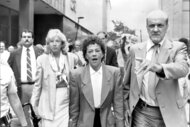Create a free profile to get unlimited access to exclusive videos, breaking news, sweepstakes, and more!
What Is The 'Reid Technique,' And Was It Used In The Interrogation Of The Central Park 5?
The Reid technique, a technique used to interview suspects, was referenced in the new Netflix series "When They See Us." What is it and was it used in that case?

While the average person may not know the term “Reid technique,” they probably would recognize some of the tactics involved. It and other controversial methods have been used to extract confessions from suspects for decades. Some believe it may have been used — or, rather, misused — in getting the suspects to confess in the controversial “Central Park 5” case.”
“When They See Us," Ava DuVernay's four-part Netflix film, revisits a painful chapter in the New York City’s history, one in which five teens of color were wrongfully accused, convicted and imprisoned for the brutal 1989 rape of a white woman jogging in Central Park. It illuminates the questionable tactics used by investigators and prosecutors to elicit confessions from the boys at the time.
The boys, now men, say they were coerced into confessing to a rape that they didn’t commit. The new series depicts authorities promising the boys that they can go home if they confess, all without adults present; they are also deprived of food and bathroom visits. In both the series and reality, all five were exonerated of the crime after the real rapist came forward. If the depictions of the interrogations are indeed accurate, they cast some police interrogation techniques in a pretty unfavorable light.
“It shows you the errors of police investigation — of manipulative Reid technique interrogation,” Criminal defense attorney and blogger Scott H. Greenfield told Oxygen.com.
“The Reid technique has been universally rejected,” the character based on Detective Michael Sheehan, who interrogated the boys, is told after the real rapist confesses in Part Four of the series.
Indeed, the technique has been rejected — at least by one firm that trains investigators in how to interview suspects.
Wicklander-Zulawski & Associates, Inc., stopped teaching the Reid technique, as well as any other technique falling under the umbrella of confrontational methods of interrogations, in 2017. The consulting group had been teaching the Reid technique since 1984, but now trains investigators with alternatives, in light of recent research findings.
“It wasn’t just the obvious misuse of this technique that has resulted in so many wrongful convictions and false confessions,” Wicklander-Zulawski & Associates VP David Thompson told Oxygen, speaking about confrontational methods as a whole, “but, really, the amount of our … that were asking for different measures, because of their discomfort and knowledge of the possible dangerous outcomes of using such methods.”
In “When They See Us,” Sheehan’s character argues he didn’t even know what the Reid technique was when he is questioned, arguing that he was just doing what he was taught to do.
What exactly is the Reid technique?
Consultant and polygraph expert John Reid, who runs the private practice John E. Ried and Associates, developed the technique as a way of extracting information from unwilling suspects. The firm offers seminars and training programs to law enforcement.
The technique involves a three-phase process, the first two steps being Fact Analysis and Behavior Analysis Interview. The third step, which is what is usually referenced when the Reid technique is discussed, is the Reid Nine Steps of Interrogation.
Those nine steps, as described in the 2001 book “Practical Aspects of Interview and Interrogation,” are:
Direct confrontation. Advise the suspect that the evidence has led the police to the individual as a suspect. Offer the person an early opportunity to explain why the offense took place.
Try to shift the blame away from the suspect to some other person or set of circumstances that prompted the suspect to commit the crime. That is, develop themes containing reasons that will psychologically justify or excuse the crime. Themes may be developed or changed to find one to which the accused is most responsive.
Try to minimize the frequency of suspect denials.
At this point, the accused will often give a reason why he or she did not or could not commit the crime. Try to use this to move towards the acknowledgement of what they did.
Reinforce sincerity to ensure that the suspect is receptive.
The suspect will become quieter and listen. Move the theme of the discussion towards offering alternatives. If the suspect cries at this point, infer guilt.
Pose the "alternative question", giving two choices for what happened; one more socially acceptable than the other. The suspect is expected to choose the easier option, but, whichever alternative the suspect chooses, guilt is admitted. As stated above, there is always a third option, which is to maintain that they did not commit the crime.
Lead the suspect to repeat the admission of guilt in front of witnesses and develop corroborating information to establish the validity of the confession.
Document the suspect's admission or confession and have him or her prepare a recorded statement (audio, video or written).
Was the Reid technique used with the Central Park Five?
While the technique is alleged to have led to false confessions, John E. Reid President Joseph P. Buckley told Oxygen.com that he disputes that. Buckley claims that false confessions are not the result of the Reid technique, but of the abuse or misuse of the technique. His firm has stated that the process does not create false confessions.
In a 53-page John E. Reid document entitled “Clarifying Misrepresentations About Law Enforcement Interrogation Techniques” obtained by Oxygen.com, the firm states that the minimization of legal consequences is something “we teach never to do.” If the investigators on the Central Park 5 case interrogated the boys, as depicted in “When They See Us,” they promised them fewer legal consequences if they gave the authorities what they wanted. They also threatened the boys if they did not comply. That, in theory, led to the false confessions.
In an email, Buckley wrote, “If the investigators in this case had followed the Core Principles of the Reid Technique and the Best Practices that we teach ... [the] end result would have been very different.”
Among those Core Principles: “Do not threaten the subject with any physical harm or inevitable consequences” and “Do not conduct interrogations for an excessively lengthy period of time.”
Thompson agreed that, if the Reid technique was in fact used to some degree, it was misused.
Regardless of whether confrontational interrogations are being used exactly as taught or twisted from their original intentions, Thompson told Oxygen.com that evidence proves confrontational interrogations can yield false confessions. He pointed to Brendan Dassey, of “Making a Murderer” fame. That documentary suggested that investigators took advantage of Dassey’s limited intellect and a confrontational interrogation to coax him into confessing.
Thompson said there are three things that could go wrong in an interrogation room and lead someone to falsely confess: Misclassification, coercion and contamination. Coersion, and explicit threats and promises made to Dassey by law enforcement, Thompson said, were obvious in the video of his interrogation. As for misclassification, he believes that law enforcement may have misclassified the body language and behavior of Dassey, who has developmental challenges, as indications of guilt. He said the tactics mirrored what happened in the depiction of the Central Park 5 suspects in “When They See Us,” adding that misclassification can also occur when it comes to racial and age bias.
He said that such “heartbreaking” high-profile cases prompted his firm to stop teaching confrontational interrogations.
What is being taught to law enforcement now?
While Thompson couldn’t give an exact number on how many police departments still use confrontational techniques, or have stopped doing so since 2017, many have been receptive to using alternate approaches to interviewing suspect, he said.
“There should never be a one-size-fits-all approach to conducting an interview or interrogation,” he said.
It should be noted that the John E. Reid and Associates website noted that Wicklander-Zulawski & Associates was only licensed to teach their material as it existed in 1984, and that they haven’t been allowed to teach or use any of their material or advancements since then. They have stated “we teach never to engage in the coercive tactics.”
John E. Reid and Associates still offers one to three-day training programs for the Reid technique.
Wicklander-Zulawski & Associates now teaches non-confrontational methods only. They offer several types of fact and information-gathering techniques, including one called the participatory method, the goal of which “is to detect as much information as possible to potentially eliminate any explanations for that evidence,” according to Thompson. He said that, based on the evidence gathered in those types of interviews, “if there is a decision to make an accusation we use a non-confrontational approach to that conversation. We offer investigators multiple options which depends on the crime and suspect.”
Thompson said Wicklander-Zulawski & Associates urges electronic recording of everything — the interview process from from start to finish, and not just the confessions. In the Central Park 5 case, only the confessions were videotaped.
Thompson said that many law enforcement officials he has spoken to are relieved to change methods. Even though Wicklander-Zulawski & Associates only stopped teaching confrontational techniques to law enforcement about two years ago, they stopped teaching them to their non-law enforcement clients, like human resource departments, decades ago.
“It’s already been kind of acknowledged for decades that many of our clients don’t like to talk to some of our clients using those methods,” Thompson said, adding, “about two years ago, we decided if we are leaders in the [law enforcement] industry we have to take a stand.”
He said that “When They See Us” does a great job of depicting interrogations gone wrong.
“I’m hoping that it’s inspiring for people to advocate for change, to learn how to do things the right way, and to take a stand, even when you are in a position where it might be difficult to do so,” he said.























